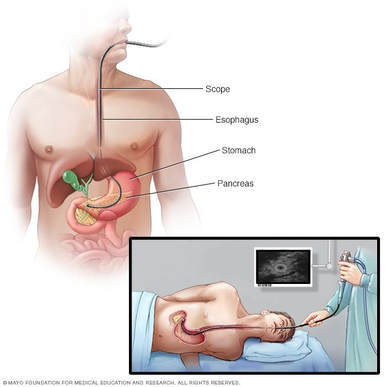Before a surgeon performs surgery, they need to know some information about the patient. This includes cancer type, what stage the cancer is, location, etc. This information can be found doing imaging tests, ultrasound, CT, MRI, or by performing a laparoscopy. A laparoscopy is a minimally invasive procedure that will give doctors more information about the cancer than what can be found on images. A laparoscopy consists of a few small cuts made in the abdomen. Long thin instruments are inserted, one of which is a video camera. The surgeon can visualize in real time what is going on inside your abdomen. In the case of pancreatic cancer the surgeon can look at the pancreas and the surrounding organs and take samples or biopsies from abnormal areas. These samples are then tested to determine the type of cancer, stage, and if the cancer has spread to other parts of the body. Once the proper information is gathered the surgeon can provide their patient the proper treatment or surgery necessary.
There are 2 types of general surgery used in pancreatic cancer:
There are 2 types of general surgery used in pancreatic cancer:
- Potentially curative surgery- removing all the cancer, typically done to treat tumors on the head of the pancreas. Tumors on the head of the pancreas can cause jaundice (yellowing of the skin) which allows for early detection of the tumor. Curative surgery is very risky to patients with pancreatic cancer. Pancreatic cancer is difficult to diagnose because of delayed symptoms. When a surgeon plans to perform a curative surgery, once the surgeon begins operating it is possible they will find the tumor is inoperable and they are unable to remove all of the cancer. In these cases the surgeon will opt to perform a palliative surgery. There are three types of potentially curative surgeries.
- Whipple Procedure (pancreaticodudenectomy)- most common procedure to remove exocrine pancreas cancers. Mainly used to remove tumors found on the head of the pancreas.
- Distal pancreatectomy- tail of the pancreas is removed and a portion of the body.
- Total pancreatectomy- removes the entire pancreas, gallbladder, and part of the stomach, small intestine, and the spleen.
- Palliative surgery- cancer cannot be removed completely, and is used to relieve symptoms and prevent complications.
- Stent placement- a small tube is placed in a blocked bile duct to keep it open.
- Bypass Surgery- relieving a blocked bile duct, by rerouting bile from the common bile duct to the small intestine.
https://www.cancer.org/cancer/pancreatic-cancer/treating/surgery.html


